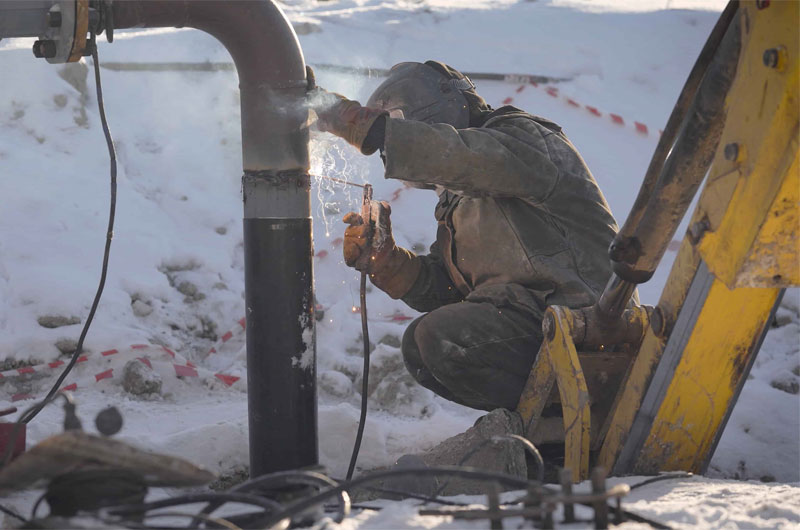Stick welding, or Shielded Metal Arc Welding (SMAW), is widely used in construction, pipeline repair, shipbuilding, and industrial maintenance due to its simplicity, portability, and ability to weld in challenging environments.
One of the key advantages of stick welding is its ability to perform reliably in harsh weather conditions. While other welding methods falter under adverse weather, stick welding remains effective, but only when proper procedures and precautions are followed.
This article explores how stick welding performs in extreme weather, including cold, heat, wind, and moisture, and offers best practices to ensure safety and weld quality.
Understanding Stick Welding
Stick welding employs a flux-coated consumable electrode to produce the weld. As the arc forms between the electrode and the base metal, both are melted, while the flux coating generates a protective slag that shields the molten weld from atmospheric contamination. This built-in protection makes SMAW more forgiving in outdoor or rough environments compared to processes like TIG or MIG welding.
Advantages of Stick Welding in Harsh Conditions
Despite the challenges, stick welding remains the go-to process for field work due to:
- Portability: Compact equipment allows for remote welding in off-grid locations.
- No External Shielding Gas: Unlike MIG or TIG, there’s no need for gas tanks or protection from wind.
- Versatility in Electrode Types: Electrodes like E6010 and E7018 are engineered for specific conditions and applications.
Challenges of Extreme Weather Conditions

1. Cold Weather Welding
Cold weather presents a unique set of challenges for welders:
- Brittle Welds: Cold temperatures can cause weld metal and base materials to become brittle, increasing the risk of cracking.
- Increased Hydrogen Cracking Risk: Cold slows down hydrogen diffusion, raising the potential for hydrogen-induced cracking.
- Difficulty Starting the Arc: Electrodes may be harder to strike and maintain an arc in freezing conditions.
Best Practices for Cold Weather:
- Preheat the Base Metal: Especially for thicker materials or high-strength steels, preheating helps reduce thermal gradients and prevents cracking.
- Use Low-Hydrogen Electrodes (e.g., E7018): These electrodes reduce the risk of hydrogen-induced cracking.
- Keep Electrodes Dry and Warm: Store electrodes in rod ovens to protect them from absorbing moisture.
- Dress Appropriately: Wear thermal but flame-resistant clothing to maintain comfort and dexterity.
2. Hot Weather Welding
In extremely hot environments, welders must contend with:
- Weld Metal Weakness: High ambient temperatures can cause premature solidification and reduce mechanical properties of the weld.
- Fatigue and Dehydration: Heat stress can impair concentration and increase the chance of mistakes.
- Increased Slag Fluidity: Excess heat can change the behavior of flux and slag, affecting coverage and protection.
Best Practices for Hot Weather:
- Hydrate Frequently: Dehydration can cause dizziness and affect focus—both dangerous while welding.
- Shade the Work Area: Set up welding screens or tents to protect from direct sun exposure.
- Schedule Smartly: Schedule welding tasks during cooler times of the day, such as early morning or late afternoon.
- Wear Ventilated Protective Gear: Wearing flame-resistant clothing with proper ventilation helps manage body temperature during welding.
3. Windy Conditions
Wind is particularly problematic in welding because it disrupts shielding gases—but even in SMAW, it can:
- Blow Away the Protective Slag: Exposing the molten weld pool to oxygen and nitrogen can cause porosity or oxidation.
- Cool the Weld Rapidly: Increasing the risk of cracking, especially in thick or high-strength materials.
- Interfere with Arc Stability: This makes it more difficult to maintain precise control of the weld puddle.
Best Practices for Windy Conditions:
- Use Windbreaks or Shelters: Construct temporary barriers using fireproof materials to block gusts.
- Select Proper Electrodes: Electrodes with robust flux coatings (like E6010 or E7018) offer better protection.
- Shorten Arc Length: A tighter arc helps protect the molten pool from wind disruption.
- Weld in Sections: If high winds make continuous welding difficult, break the job into smaller, manageable sections.
4. Rain and Humidity
Moisture is among the most hazardous elements during welding due to:
- Hydrogen Embrittlement: Water can introduce hydrogen into the weld metal, leading to cracking.
- Electrical Shock Hazard: Welding in wet conditions significantly increases the risk of electrical shock.
- Poor Weld Quality: Wet base metals or electrodes result in porosity, slag inclusion, and weak joints.
Best Practices for Wet Conditions:
- Avoid Welding in Rain: If unavoidable, create a fully enclosed, dry, and ventilated shelter.
- Dry Electrodes and Base Metal: Always ensure surfaces are dry before beginning work.
- Use Insulated Mats: Stand on rubber mats or dry platforms to minimize shock hazards.
- Wear Waterproof PPE: Gear should be both flame-resistant and waterproof when working near water or humidity.
Equipment Considerations in Extreme Weather
- Electrode Storage: Invest in portable rod ovens to keep electrodes warm and dry regardless of outdoor conditions.
- Welder Maintenance: Check cables and connections frequently, especially after exposure to rain or snow, to prevent shorts or arcing.
- Machine Placement: Keep welding machines sheltered from direct exposure to the elements to maintain stable output and prevent damage.
Safety First
Extreme conditions amplify the inherent hazards of welding. Follow these safety tips:
- Always Wear Proper PPE: Adjust gear for the weather but never sacrifice protection.
- Use GFCI-Protected Power Supplies: These components help minimize the risk of electric shock in damp or humid conditions.
- Monitor Physical Condition: Watch for symptoms of cold stress or heat exhaustion, and take breaks as needed.
- Have Fire Extinguishers Nearby: Especially in dry, windy conditions where sparks can spread.

